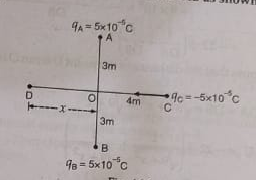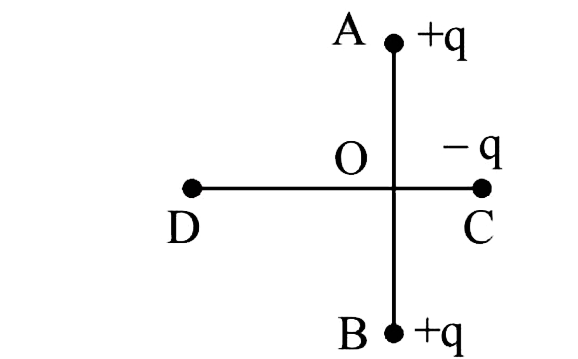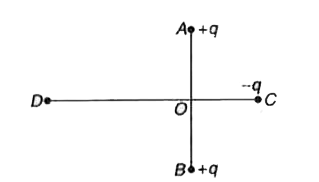Two fixed, equal, positive charges, each of magnitude 5xx10^-5 coul are located at points A and B separated by a distance of 6m. An equal and opposite charge moves towards them along the line COD, the perpendicular bisector of the line AB.
The moving charge, when it reaches the point C at a distance of 4m from O, has a kinetic energy of 4 joules. Calculate the distance of the farthest point D which the negative charge will reach before returning towards C.
 Solution in Punjabi
Solution in Punjabi
Step by step video & image solution for Two fixed, equal, positive charges, each of magnitude 5xx10^-5 coul are located at points A and B separated by a distance of 6m. An equal and opposite charge moves towards them along the line COD, the perpendicular bisector of the line AB. The moving charge, when it reaches the point C at a distance of 4m from O, has a kinetic energy of 4 joules. Calculate the distance of the farthest point D which the negative charge will reach before returning towards C. by Physics experts to help you in doubts & scoring excellent marks in Class 12 exams.
Updated on:21/07/2023Topper's Solved these Questions
Similar Questions
Find an expression for line integral of electric intensity.
View SolutionIn defining electric field due to a point charge, the test charge has to be vanishingly small. How this condition can be justified, when we know that charge less than the on an electron or a proton is not possible?
View SolutionState and explain Kirchhoff's laws.
View SolutionTwo fixed, equal, positive charges, each of magnitude 5×10−5 coul are located at points A and B separated by a distance of 6m. An equal and opposite charge moves towards them along the line COD, the perpendicular bisector of the line AB.
The moving charge, when it reaches the point C at a distance of 4m from O, has a kinetic energy of 4 joules. Calculate the distance of the farthest point D which the negative charge will reach before returning towards C.

View SolutionTwo charges +Q each are fixed at points C and D. Line AB is the bisector line of CD. A third charge +q is moves from A to B, then from B to C
View SolutionTwo equal charges q of opposite sign are separated by a small distance 2a ,The electric intensity E at a point on the perpendicular bisector of theline joining the two charges at a very large distance r form the line is
View SolutionTwo point charges of 1muC and -1muC are separated by a distance of 100 Å. A point P is at a distance of 10 cm from the midpoint and on the perpendicular bisector of the line joining the two charges. The electric field at P will be
View SolutionTwo equal and opposite charges separated by a finite distance is
View SolutionTwo point charges −2nC and +8nC are separated in air by a distance of 0.10m.Find the position of the neutral point along the line joining the 2 point charges.
View SolutionTwo fixed charges "A" and "B" of 5μC each are separated by a distance of "6m" .C is the mid point of the line joining "A" and "B" .A charge Q of −5μC is shot perpendicular to the line joining "A" and "B" through "C" with a kinetic energy of "0.06" J. The charge 'Q' comes to rest at a point "D" .The distance "CD" is (a) 3m (b) √3m (c) 3√3m(d) 4m
View SolutionAt any point on the right bisector of line joining two equal and opposite charges
View Solutionदो धन आवेश q,q(q=5×10−5 कूलॉम) बिन्दुओं A व B पर स्थिर हैं। जिनके बीच 6 मी की दूरी है। एक अन्य आवेश -q रेखा AB के लम्ब अर्दधक (perpendicular bisector) COD के अनुदिश चलता है। जब यह O से 4 मीटर बिंदु C तक पहुँचता है तो इसकी गतिज ऊर्जा 4 जूल है। उस दूरस्थ बिन्दु D की O से दूरी ज्ञात कीजिए जहाँ पहुँच कर यह पुन: C की ओर लौटने लगेगा।

View Solution5μC के दो स्थायी आवेश A और B को 6m की दूरी पर रखा गया है। C , A और B को जोड़ने वाली रेखा का मध्य बिन्दु है। एक −5μC के आवेश 'Q' को A तथा B को जोड़ने वाली रेखा के लंबवत् C की ओर 0.06 J की गतिज ऊर्जा के साथ छोड़ा जाता है। आवेश 'Q' एक बिन्दु D पर विराम में होगा। CD की दूरी होगी :
View Solutionदो समान किन्तु विपरीत आवेशों को मिलाने वाली रेखा की लम्ब अर्द्धक रेखा के किसी बिन्दु पर : -
View SolutionTwo point charges of 1μCand−1μC are separated by a distance of 100 Å. A point P is at a distance of 10 cm from the midpoint and on the perpendicular bisector of the line joining the two charges. The electric field at P will be
View SolutionConsider two point charges of equal magnitude and opposite sign separated by a certain distance. The neutral point due to them
View Solution
